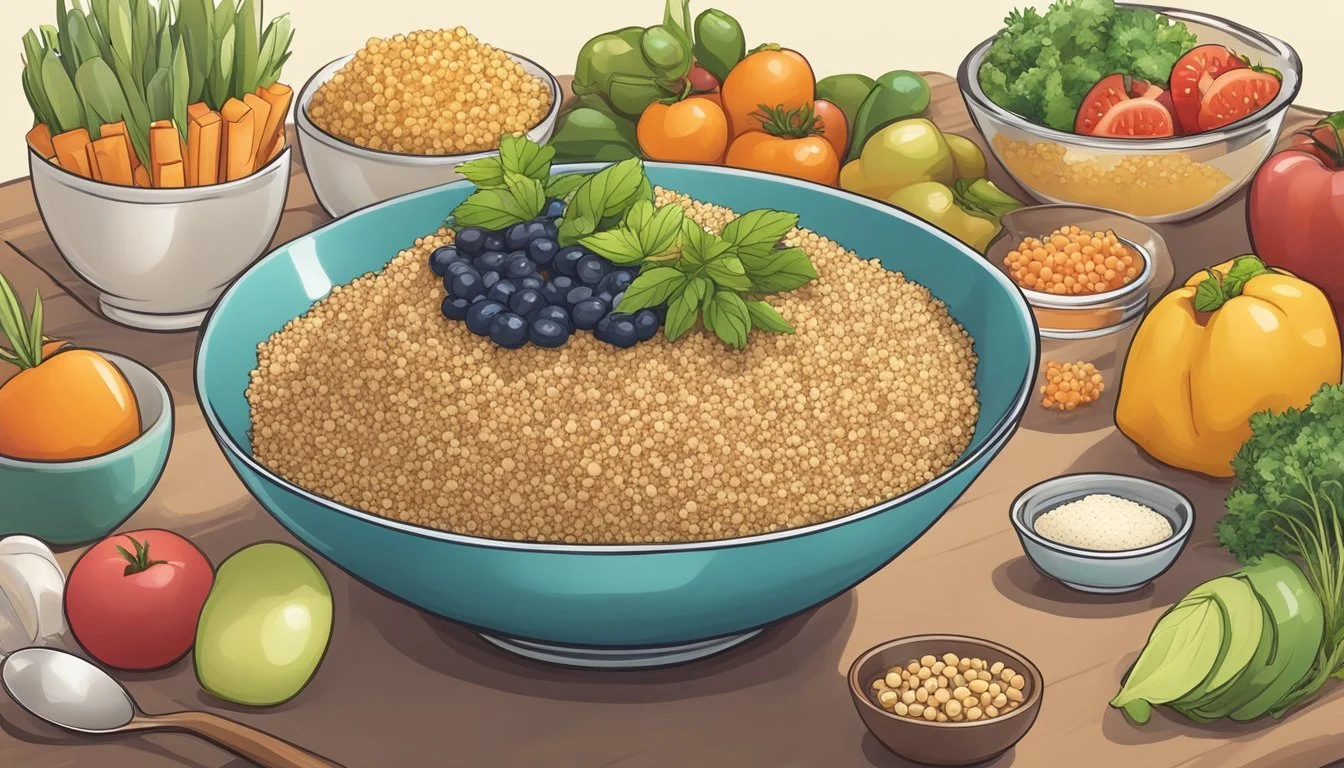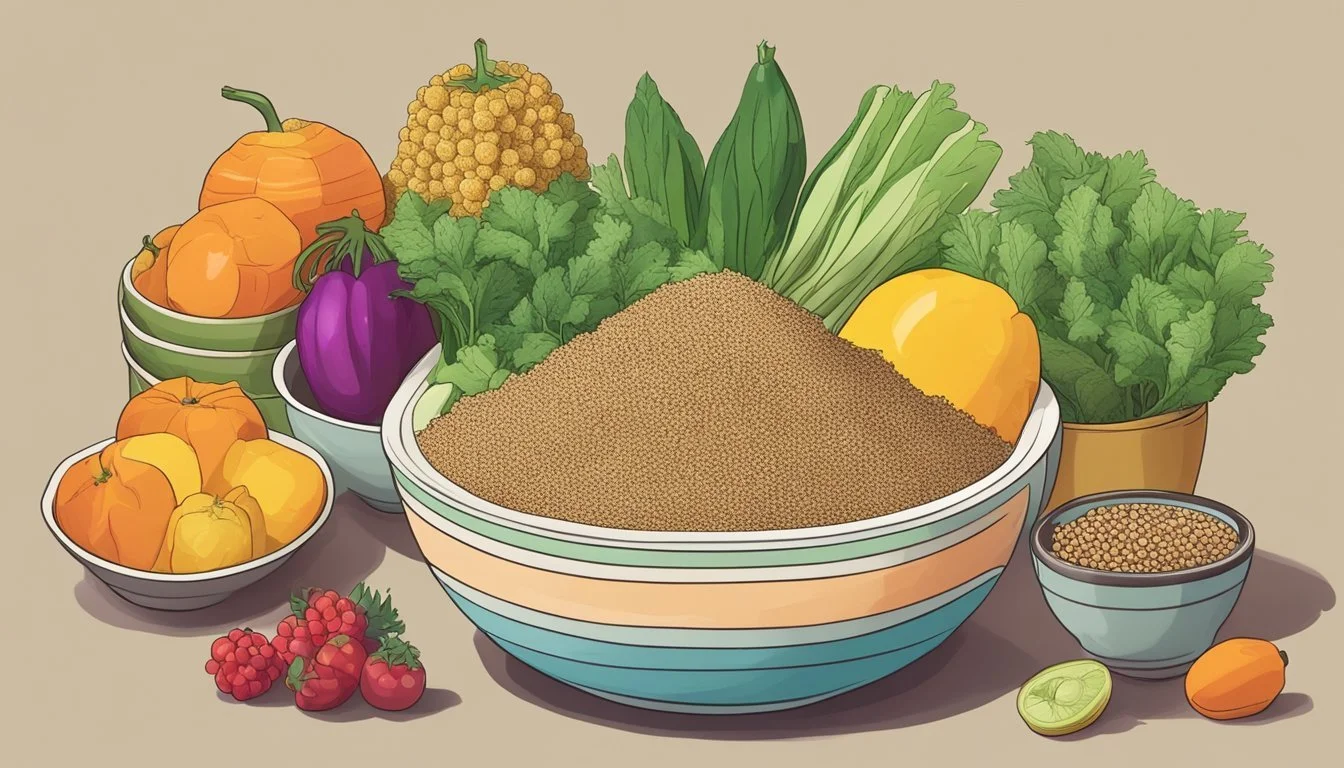How Much Quinoa Should You Include in Your Diet?
Unveiling the Optimal Daily Amount
Quinoa, (What wine goes well with quinoa?) often hailed as a superfood, is an ancient grain that originates from South America. Despite its widespread categorization as a grain, quinoa is technically a seed from the Chenopodium quinoa plant. As a whole grain, it has been a staple in the diet of Andean cultures for thousands of years, revered for its nutritional richness and adaptability in various dishes. The modern diet has adopted quinoa as a versatile ingredient that can enhance nutritional intake, particularly for its high protein content that includes all nine essential amino acids, a rarity in plant-based foods.
Incorporating quinoa into one's diet can offer numerous health benefits. It is a source of antioxidants, fiber, vitamins, and minerals, and is naturally gluten-free, making it a favorable option for those with gluten sensitivities. Determining the right amount of quinoa to include in a diet can depend on individual dietary needs and calorie requirements, but generally, it is consumed much like any whole grain. Balancing quinoa with a diversity of other foods ensures a well-rounded intake of nutrients.
Health professionals and nutritionists recognize quinoa's role in a balanced diet, particularly for those seeking weight management or an increase in their plant-based protein consumption. Given its nutrient density, quinoa provides a relatively high amount of nutrients for the calories it contains, which is particularly attractive for maintaining a healthy weight. Standard dietary recommendations suggest incorporating a variety of whole grains into one's diet, and quinoa can be a part of this whole grain intake, accompanying a diet rich in vegetables, fruits, lean proteins, and healthy fats.
Nutritional Profile
Quinoa's nutritional profile is impressive, marked by a high content of protein and fiber, along with a rich supply of vitamins and minerals. It stands out as a gluten-free whole grain that's particularly well-suited for those requiring nutrient-dense foods within their diet.
Macronutrients
Calories: A cup of cooked quinoa contains approximately 222 calories.
Protein: Each cup offers about 8 grams of complete protein, containing all nine essential amino acids.
Fat: There's roughly 3.5 to 4 grams of fat in a cup of quinoa.
Carbohydrates: It includes around 39 grams of carbohydrates.
Fiber: High in dietary fiber, quinoa provides about 5 grams per cup.
Sodium: Naturally low in sodium, with just 13 milligrams per cup of cooked quinoa.
Vitamins and Minerals
Quinoa is particularly high in the following minerals:
Magnesium: A key mineral for muscle and nerve function.
Iron: Essential for the transport of oxygen in the blood.
Phosphorus: Important for bone health.
Manganese: Plays a role in antioxidant function.
Folate: Vital for DNA synthesis and repair.
In terms of vitamins, quinoa provides a modest amount of B-vitamins, necessary for energy metabolism.
Antioxidants and Phytonutrients
Quinoa is a good source of various antioxidants and phytonutrients, which contribute to reducing oxidative stress in the body. These compounds are essential for maintaining overall health and protecting against various diseases.
Health Benefits
Quinoa is recognized for its wide array of health benefits, from aiding in weight management to supporting cardiovascular health. The nutrient profile of quinoa, rich in fiber and a complete source of protein, makes it a beneficial addition to various dietary needs.
Weight Management and Satiety
Quinoa is high in fiber and protein, which can promote feelings of fullness and reduce overall calorie intake. Its role in satiety may assist in weight management, making it a suitable choice for those monitoring their weight.
Cardiovascular Health
This whole grain may contribute to heart health due to its content of essential amino acids and a notable amount of omega-3 fatty acids. Regular consumption of quinoa can assist in maintaining healthy blood pressure and triglyceride levels, which are vital for cardiovascular health.
Blood Sugar and Diabetes Control
Quinoa's complex carbohydrates have a low glycemic index, which means they raise blood sugar at a slower and more steady rate. This characteristic is particularly useful for individuals managing type 2 diabetes, as it aids in maintaining stable blood sugar levels.
Digestive Health
The high fiber content in quinoa not only promotes satiety but also aids in digestion and regularity. Quinoa is also gluten-free, making it a safe and healthful choice for individuals with celiac disease or those following a gluten-free diet.
Anti-inflammatory Properties
Quinoa contains antioxidants and nutrients with anti-inflammatory properties, which can help reduce inflammation in the body. This may have implications in preventing conditions like cancer and in promoting overall health.
Dietary Considerations
When incorporating quinoa into a diet, understanding its impact on specific dietary needs is crucial. Quinoa is celebrated for its high nutrient content and versatility across various diets.
Gluten-Free Eating
Quinoa is naturally gluten-free, making it a suitable grain for individuals with celiac disease or gluten intolerance. It provides a source of carbohydrates and fiber without the gluten found in many other grains. As a nutrient-dense food, quinoa offers a wealth of essential nutrients beneficial for maintaining a healthy weight.
Vegetarian and Vegan Diets
For vegetarians and vegans, quinoa is a valuable source of protein that contains all nine essential amino acids, making it a complete protein. It can be an integral part of plant-based diets, contributing to meeting protein requirements and providing important minerals and fiber.
Low-Cholesterol Diet
Quinoa can be a heart-healthy addition to a low-cholesterol diet. It contains no cholesterol and is low in unhealthy fats. When managing cholesterol levels, incorporating quinoa may support cardiovascular health, thanks to its profile of omega-3 fatty acids and potentially cholesterol-lowering fiber content.
Glycemic Index Information
The glycemic index (GI) of quinoa is relatively low, meaning it has a minimal impact on blood sugar levels when consumed in moderation. This is beneficial for those monitoring their blood sugar, as quinoa can provide sustained energy without the spikes associated with high-GI foods. A standard serving size is typically 1/2 cup to 1 cup of cooked quinoa.
Quinoa is coated with naturally occurring saponins, which can taste bitter. Rinsing quinoa before cooking can remove these compounds, ensuring a better taste and preventing any potential irritation in the digestive system.
Quinoa in the Kitchen
Quinoa's versatility in cooking allows for a wide range of culinary uses, from breakfast options to dinner entrees, offering a nutritious addition rich in protein and fiber.
Cooking Techniques
When cooking quinoa, one can use water or broth to infuse it with flavor. For a nutty taste, toasting quinoa in olive oil before adding the liquid is recommended. A standard technique involves bringing the quinoa and liquid to a boil, then simmering it covered on low heat for about 15 minutes. For convenience, using an Instant Pot reduces this process to roughly 1-3 minutes of pressure cooking, followed by a natural release.
Recipe Ideas
Quinoa is highly adaptable in recipes. For breakfast, try incorporating it into porridge or pancakes. For lunch or dinner, it serves well as a base for salads or as a side, complementing its nutty flavor with a variety of dressings and herbs. Quinoa can be added to soups or used to make hearty stuffed peppers. As a snack, consider quinoa bars or energy bites.
Pairing with Other Foods
Quinoa pairs well with a broad spectrum of foods. Its subtle nutty flavor complements both sweet and savory ingredients. For a balanced meal, combine red, black, or white quinoa with legumes, fresh vegetables, or lean proteins. It can also be mixed with dried fruits (What wine goes well with dried fruits?) and nuts for a textural contrast.
Storing and Preservation
To retain freshness, store cooked quinoa in an airtight container in the refrigerator for up to a week. For long-term storage, it can be frozen for up to a month. Dry quinoa should be kept in a cool, dry place away from direct sunlight. Ensure it is sealed properly to prevent moisture absorption and preserve its quality.
Comparisons with Other Foods
When considering quinoa in relation to other foods, it's important to examine its nutritional profile compared to common alternatives such as rice, other whole grains, and various sources of protein. This comparative approach offers insights into how quinoa can fit into a balanced diet.
Quinoa vs Rice
Quinoa offers a higher protein content and a complete amino acid profile when compared to both white and brown rice. While a cup of cooked quinoa contains about 8 grams of protein, white rice contains roughly 4 grams, and brown rice comes closer with approximately 5 grams. Quinoa is also lower in carbohydrates and higher in fiber, making it a more favorable option for those looking to reduce their carb intake. Moreover, quinoa has a lower glycemic index than white rice, implying a more gradual impact on blood sugar levels.
Nutrient Quinoa (1 cup cooked) White Rice (1 cup cooked) Brown Rice (1 cup cooked) Protein 8 grams 4 grams 5 grams Carbohydrates 39.4 grams 45 grams 45 grams Fiber 5.2 grams 0.6 grams 3.5 grams Calories 222 205 218
Quinoa vs Other Whole Grains
Comparing quinoa to other whole grains like wheat and farro, quinoa generally cooks faster and packs more nutrients per serving. For example, while farro takes about 30 to 40 minutes to cook, quinoa is ready in approximately 15 minutes. When measured against other grains, quinoa tends to have less Selenium, Manganese, Phosphorus, Copper, Vitamin B3, Zinc, Vitamin B1, Iron, Vitamin B6, and Magnesium. However, it's gluten-free and a great alternative for those with gluten sensitivities or celiac disease.
Quinoa vs Other Sources of Protein
Quinoa is a plant-based protein source, making it a good option for vegetarians and vegans. Unlike many plant proteins, it contains all nine essential amino acids, making it a complete protein, akin to animal products like milk. It is also low in calories and sugar, offering a healthy alternative to animal proteins. While high-protein vegetables exist, they typically do not provide a complete protein profile without combining them with other foods.
Source Protein (per cup cooked) Complete Protein Calories Quinoa 8 grams Yes 222 Lentils 18 grams No 230 Chicken Breast (100g) 31 grams Yes 165 Milk (1 cup) 8 grams Yes 149
By comparing quinoa with rice, other whole grains, and various protein sources, it is clear that quinoa can serve as a nutritious and versatile component in a variety of diets.
Varieties and Selection
When selecting quinoa for inclusion in the diet, consumers should be aware that different varieties can offer distinct flavors, nutritional profiles, and culinary uses. Quinoa, often referred to as an ancient grain, is actually a pseudocereal and an edible seed.
Color Varieties
Quinoa comes in three main color varieties:
White quinoa: The most common type, with a light flavor and fluffy texture upon cooking.
Red quinoa: Holds its shape better than white quinoa, with a heartier texture and a slightly nutty flavor.
Black quinoa: Has an earthier taste and is slightly sweeter than white and red quinoa.
All types generally have the same cooking process, although cook times can slightly vary. These color varieties are often available as a tri-color mix, providing a visually appealing combination.
Nutritional Differences
Despite the color differences, the nutritional content across types of quinoa is similar. All are:
High in protein, containing all nine essential amino acids.
A good source of fiber, which aids in digestion.
Rich in flavonoids, such as quercetin and kaempferol, which have antioxidant properties.
One potential difference is the saponin content, which is a natural coating that can create a bitter taste; it's typically higher in darker varieties. Saponins must be rinsed off before cooking to improve flavor.
Taste and Culinary Uses
The taste of quinoa can vary from variety to variety:
White quinoa: Its mildly nutty flavor makes it versatile, suitable for both sweet and savory dishes.
Red quinoa: Its robustness complements salads and side dishes that require grains to maintain a firm texture.
Black quinoa: Its sweetness pairs well with fruits or in recipes where a strong grain flavor is desired.
Quinoa is a whole grain and can be used in any recipe calling for grains such as rice or couscous. The nutty flavor of quinoa makes it a flavorful addition to breakfast cereals, salads, soups, and stews.
Purchasing and Sustainability
When it comes to incorporating quinoa into one's diet, thoughtful purchasing decisions are crucial not only for personal health but also for environmental sustainability. Consumers should consider organic and non-GMO options along with the broader ecological effects entailed by quinoa production.
Choosing Organic and Non-GMO
Organic quinoa is cultivated without the use of synthetic pesticides and fertilizers. It adheres to stringent organic farming regulations that aim to preserve natural resources and avoid chemical runoff. Choosing organic quinoa can also reduce exposure to saponin, a natural coating on quinoa that can impart a bitter taste and is often removed during processing. Non-GMO quinoa ensures the grain has not been genetically modified and maintains the integrity of this ancient grain's genetic lineage as traditionally cultivated in South America.
Environmental Impact
The rapid increase in quinoa's popularity has both positive and negative implications for sustainability. The demand has provided economic opportunities for South American farmers, elevating quinoa as a valuable export. However, this demand spike has led to agricultural expansion, which presents challenges such as soil degradation and water resource strain. Consumers should seek out brands that support sustainable farming practices to ensure that the impact on the land is minimized and the cultivation methods used are in alignment with long-term ecological balance.







